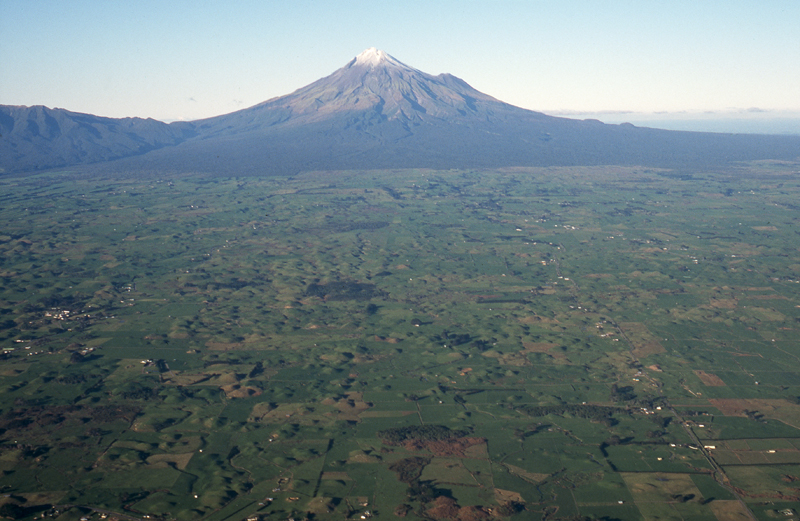



Taranaki's mountain has a history of repetitive violence. Massey University Professor Vince Neall says Mount Taranaki, which geologists call the Egmont Volcano, has been formed by at least five major cone collapses. This is a rarity in the volcanic world. "There have been these huge gravitational collapses, which are difficult for the human mind to comprehend," says the geologist. "On at least five occasions in its history, a cone the size of the present Mount Taranaki has simply collapsed sideways like Mount St Helens did in 1980.
"Some volcanoes don't do that and some volcanoes might do it once in their history, but there are only a handful around the world that do it repeatedly. Egmont is one of those." Others include, Mount Popocatépetl outside Mexico City, Volcán de Colima on the western Pacific coast of Mexico, Mount Shasta in California and Mount Rainier in Washington State.
Vince has spent his geology career studying Taranaki's volcanic history, and even chose it as his PhD topic in the 1960s. Through his field research, he has found first-hand evidence of these early cone collapses. "I have been privileged to have been involved in the mapping of these deposits that we didn't know the significance of before," Vince says.
"There is this incredibly complicated volcanic history to this mountain that we are still unravelling – it's 100 times more complicated than people portrayed prior to 1960. It's a challenge for us to work out the sequence of events; there would have literally been thousands of eruptions over its history."
Vince says the road cuttings on the way up to the Stratford Plateau, show evidence of at least 20 bigger eruptions. "But there's a multiplicity of little ones between these, which have only left a millimetre of ash behind."
He puts this in context by looking at the Mount Ruapehu eruptions of 1995 and 1996. "We recorded over 30 lahars (wet flows of mud, sand and gravel), yet I can only show you one of these – all the rest have been erased by rivers. You will only see the recordings of the big events. That's why we drill cores in lakes and swamps to find the past history of volcanoes and, in between the ashes, you then have sediment and peat. We radiocarbon date the peat layers," he says.
All these clues show Mount Taranaki has been a wild one – and will be again. "Of course, what's on everybody's mind was, when was the last eruption?"
Vince says there was a small eruption about AD1755, which created what is known as the Tahurangi Ash. The last major hazardous eruption happened about AD1500, when several extremely hot clouds of gas and debris flowed from the crater and destroyed much of the forest on the north-western slopes. About 150 years later, flying pumice buried a Māori campsite near the Stratford Mountain House.
At the beginning of the 21st Century, Mount Taranaki appears to be peaceful. This is known for certain, via the seismic survey stations monitoring the mountain. But residents should never be complacent. The mountain is just asleep – not extinct. Whether future activity will be a big blast or a minor flare-up lies with the Earth.
However, Vince believes the next blow-up may be fairly small. "Compared with the literally thousands of eruptions, the big cone collapses have only occurred on five or ten occasions, so the more likely event to happen in the future will be further eruptions from the summit crater, with small collapses into surrounding gorges with volcanic mudflow, or lahars extending down the main river valleys."
Mount Taranaki first became active 130,000 years ago, which makes it the youngest of the region's volcanoes. "The earliest volcanic activity preserved on land is Paritutū and the Sugar Loaf Islands," he says of the landscape features beside Port Taranaki in New Plymouth. These formed 1.75 million years ago, about the same time human beings evolved. That was also about the time the world became subject to the ice ages, with warm periods in between.
"All of western Taranaki has been built up out of the sea by these volcanoes." Paritutū and the Sugar Loaf Islands are remnants of something far larger. "They are literally the stubble of a volcano, where all the soft rocks have been eroded by the sea," Vince says. "These are the last vestiges of that volcanic centre."
Next up are the Kaitake and Pouākai ranges. The former, which is the backdrop to the township of Ōakura, is thought to have been active about 500,000 years ago. "There have been hot hydro thermal solutions that have altered a lot of the rocks there and this makes them difficult to work with and to date," Vince says. "But one or two vestiges of lava flows there give us the date of half a million years." Pouākai is about as old as Kaitake, but has had a more energetic life.
"Recent work that we have been doing indicates that Pouākai is probably of similar age to Kaitake, but it kept on being active until about 240,000 years ago. That built up an extensive apron of broken rock fragments around it," Vince says of the now extinct volcano. When the ‘Egmont Volcano’ arrived on the scene 130,000 years ago, it destroyed the southern two-thirds of the Pouākai ringplain. "The only remnant of it is the hills around Eltham."
On the other hand, Mount Taranaki's cloak is long and full. "The ringplain that Egmont has built is many times the volume of the actual cone that we see within the Egmont National Park," Vince says. "This is evidence of all the previous cones that have collapsed."
Standing 2518 metres high, Mount Taranaki dominates the region's landscape. It also has one other feature over its sibling volcanoes. While Paritutu, the Sugar Loaf Islands, Kaitake and Pouākai are all extinct, Mount Taranaki still has an active future. And it could be well be wild.
New scientific evidence shows that Mount Taranaki erupted just 150 years ago - 100 years later than previously recorded. That is according to PhD student Thomas Platz, who is a recipient of the George Mason Charitable Trust Scholarship administered by the Taranaki Research Centre in Puke Ariki.
According to Platz, in the past scientists believed the mountain's last blast was in 1775. That created what is known as the Tahurangi Ash. But during his studies on an earlier eruption, Platz came across physical evidence of a small eruption in 1850s or 1860s. "It's basically different from any previous eruption," he said. "It has its own chemical signature."
Platz said it appeared that a lava dome formed on the western side of the crater. "It cooled down and, maybe ten years later, it collapsed." An old black-and-white photograph shows the dome debris came to rest about 800km above sea level. That meant it travelled 4-5km down the mountain.
To back up this new evidence, Platz would like to hear from any historians who have uncovered diary entries or newspaper records of reported earth tremors in the 1850s or '60s. "It was pretty small," he said of the volcanic activity.
His discovery comes hot on the heels of fresh information about the number and frequency of eruptions on Mount Taranaki. Core samples had shown almost 100 ash layers, suggesting the mountain had erupted at least once every 90 years, on average, over 9000 years.
Puke Ariki Heritage Collection: William Messenger’s diary entries from September and October 1857 may be a reference to an eruption on Mount Taranaki.
LinkPlease do not reproduce these images without permission from Puke Ariki.
Contact us for more information or you can order images online here.